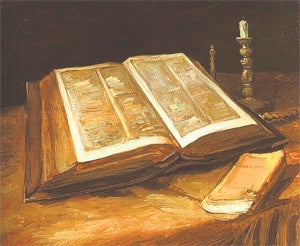Great Works: Still Life with Open Bible (1885), Vincent van Gogh
Rijksmuseum Vincent van Gogh, Amsterdam

Your support helps us to tell the story
From reproductive rights to climate change to Big Tech, The Independent is on the ground when the story is developing. Whether it's investigating the financials of Elon Musk's pro-Trump PAC or producing our latest documentary, 'The A Word', which shines a light on the American women fighting for reproductive rights, we know how important it is to parse out the facts from the messaging.
At such a critical moment in US history, we need reporters on the ground. Your donation allows us to keep sending journalists to speak to both sides of the story.
The Independent is trusted by Americans across the entire political spectrum. And unlike many other quality news outlets, we choose not to lock Americans out of our reporting and analysis with paywalls. We believe quality journalism should be available to everyone, paid for by those who can afford it.
Your support makes all the difference."The Painted Word" was the phrase coined by Tom Wolfe to mock post-war American art.
Whether abstract, pop or conceptual, none of this work could stand up for itself, he said in his book. It was wholly dependent on the critical theories, on the writing, which explained it and justified it. It was a paradoxical freak – the painted word.
Perhaps the phenomenon wasn't so strange as he thought. New arts are often decried as monsters created by critical theories – that is, until people get used to them. But never mind the arguments. The odd thing was that, in coining this phrase, Wolfe didn't seem to notice that it might have a literal sense. He didn't seem to notice that this bizarre paradox had plenty of very familiar examples.
"The Painted Word": another book could be made by taking that title straight. Look at paintings of words. You'd find that rather than being strangers to paintings, words are at home there. They introduce themselves without anyone turning a hair.
There are Annunciations, where the Angel speaks out in a streaming banner with his words written clear: "Ave Maria, gratia plena, dominus tecum..." Or there is St John the Baptist, standing in the desert, and vocalising through a furling scroll: "Ecce Agnus Dei, ecce qui tollit peccata mundi... " These are like speech bubbles avant la lettre.
There are also portraits that carry long commentaries written on their surfaces, rather like grave inscriptions, recalling the sitter's achievements. And there are many examples from the 20th century, from Surrealism to Pop Art. There is the pipe labelled "Ceci n'est pas une pipe". There is the air battle that climaxes with an enormous "Whaam!" These are images where half the work is done by words.
But there are also those paintings that depict words – whose subject matter includes a piece of verbiage, whether written or printed. This is done in two ways. In one, the words are depicted literally, legibly, transcribed letter by letter. If the subject is handwriting, for example, the painter is almost recapitulating the action of the writer.
The other way is tonally. Here the words are no longer readable. The letters have retreated out of visibility. They've been reduced to areas of indecipherable grey. Paintings of newspapers often use both ways of depiction. The headlines are big and letter-by-letter legible. The smaller print of the stories becomes blocks of blur.
Van Gogh's Still Life with Open Bible is a picture that does text in both ways. Two books lie on a table, at a slant to one another. One is heavy and huge. It's a family bible, with brass clasps, open in the middle, and you can read at the head of the page where we are: Isaiah, 53. These pages hold a famous passage that is often referred to Jesus: "He was despised and rejected of men; a man of sorrows, and acquainted with grief..."
The other book is lighter reading. It's a small and well-thumbed paperback of a contemporary novel. The volume is closed, and we can read on its cover the author and the title fairly clearly. It's Emile Zola's Joie de Vivre. The man of sorrow. The joy of life. Some kind of drama is being staged between these two books – both between their very different physical presences and between their legible verbal content.
But now turn to the actual words of the Bible, and consider how they're painted. They're obviously not legible. You may know what the Isaiah says, but you certainly can't read it in this rendering. The text is depicted in the tonal manner. Columns of print are made into panels of blur. The paint breaks up into brush strokes here and there. You have a vague sense of chapter and verse.
It's very vague, though. This tonal version is beyond mere dark and light. This blur goes further than any loss of focus. There is no suggestion that a readable page only just eludes us – that with a little magnification, with slightly higher resolution, the viewer might become a reader. The body of the text has been transformed into rough, dense, opaque blocks of paint.
This Bible is open. We're confronted with its pages. But that only emphasises how there's no way through Van Gogh's paint to Isaiah's prophecy. His voice has been translated into thickly pasted pigment, into fat streaks and slabs, closely packed gestures going both up and across. The gap between what we see, and what's meant to be there, is wrenching.
Is the effect sceptical, telling us that the old message is beyond us, that its preaching is only dead matter? Or is it expressive, giving this passage a more than linguistic power, filling it with a physical force? The painted word is the word made flesh?
Join our commenting forum
Join thought-provoking conversations, follow other Independent readers and see their replies
Comments